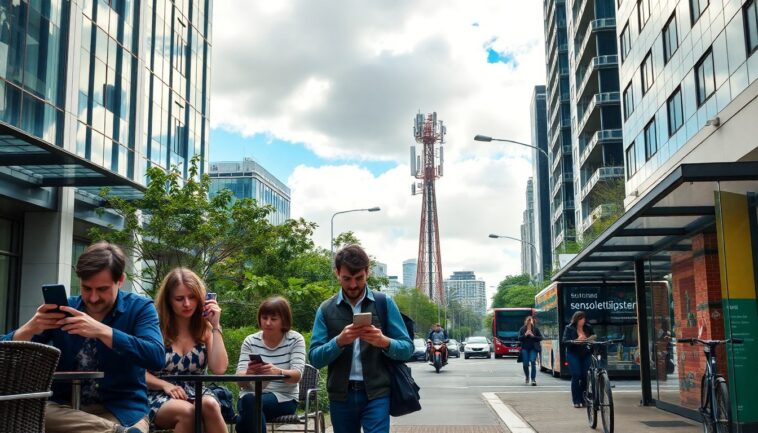The reliance on mobile phones and the internet has become an integral part of daily life for many Australians. This dependence is particularly evident during emergencies, where reliable communication can be a matter of life and death, as highlighted by the recent issues experienced by Optus with the Triple Zero service. Unfortunately, the ramifications of connectivity failures extend beyond emergency services, revealing deeper systemic issues in telecommunications across the nation.
The latest findings from the Telecommunications Industry Ombudsman have raised alarm bells, indicating a significant surge in complaints related to network connections over the past financial year. Notably, there has been an astonishing 70% increase in grievances concerning lack of phone or internet service, while reports of inadequate mobile coverage surged by over 25%. These statistics illustrate a pressing need to address the connectivity crisis affecting many regions.
Understanding the digital divide
When we think of connectivity issues, our minds often drift towards remote locations, such as rural cattle farms or Indigenous communities in Australia’s central and northern regions. However, our research reveals a critical oversight in the discussion of digital inclusion. We have identified a demographic, which we refer to as the missing middle, that resides in suburban and regional areas yet struggles with connectivity issues comparable to those in remote zones.
This group, often overlooked in telecommunications policies, experiences persistent network problems, despite living in areas that statistically appear well-connected. Factors contributing to this disconnect could include local infrastructure inadequacies and a combination of social and economic challenges. Recognizing the existence of the missing middle is pivotal for shaping more effective and inclusive telecommunications strategies.
Defining digital inclusion
Digital inclusion encompasses the necessity for all Australians to access affordable and high-quality telecommunication services while also possessing the skills to utilize them effectively.
As climate change intensifies, the importance of robust telecommunications becomes even more pronounced during natural disasters, where timely communication is vital for safety and recovery.
Our 2023 research focusing on emergency preparedness among rural residents underscored the importance of continuous connectivity. During crises, community members often rely on online platforms to share real-time information and coordinate emergency responses. Post-disaster, they turn to the internet to seek financial support, further underscoring the essential role digital connectivity plays in navigating challenges.
Geographical disparities in connectivity
Australia’s recent challenges, including cyclones, floods, and bushfires, have not only affected rural landscapes but have also significantly impacted urban areas and their peripheries. While policies have historically prioritized access to telecommunications, we must recognize that access is merely one aspect of a broader connectivity landscape.
From our extensive interviews and fieldwork conducted between 2021 and 2024, it became clear that geographic location alone does not dictate connectivity levels. Interestingly, some remote regions enjoy better telecommunications services than certain outer suburban areas. This insight prompts a reevaluation of how we define and approach digital inclusion across the country.
Compounding factors affecting connectivity
Several compounding factors determine an individual’s ability to connect digitally. Financial constraints often prevent people from obtaining adequate services, leading some to juggle multiple SIM cards to access different networks. Additionally, infrastructure investment can be uneven; while a regional hub may have excellent connectivity, surrounding satellite towns may lag significantly.
Urban developments on city fringes sometimes find themselves on the receiving end of diminishing network quality, leaving new residents with inadequate mobile coverage. For instance, a resident from a new suburb on Melbourne’s outskirts lamented the absence of usable mobile service, highlighting the disconnect between expected and actual service provision.
Dubbo, a significant regional town in New South Wales, exemplifies the challenges faced by the missing middle. While some major cities boast robust connectivity, Dubbo has been plagued with slow and unreliable network performance, which hampers local organizations’ ability to serve their communities effectively. This lack of connectivity can lead to inefficiencies, such as requiring manual documentation in the field, only to digitize it later at a location with better service.
Addressing the connectivity gaps
Efforts have been made in recent years to enhance connectivity throughout Australia. The completion of the National Broadband Network (NBN) in 2020 has allowed for more fixed-line services to become available in rural areas. Additionally, various federal initiatives, like the Regional Connectivity Program and Mobile Blackspot Program, have aimed to bolster digital inclusion across the nation.
New technologies, such as Starlink and NBN’s satellite service SkyMuster, offer fresh options for individuals in areas where traditional connectivity remains a challenge. However, current policies primarily address immediate connectivity deficiencies without fully acknowledging the scale of the missing middle.
To effectively tackle these gaps, it is crucial for policymakers to understand the nuanced needs of diverse populations utilizing digital services. A more cohesive approach that considers the intersection of various telecommunications options and addresses overlapping disadvantages will be essential. By focusing on the missing middle, we can ensure that all Australians benefit from the digital age.



